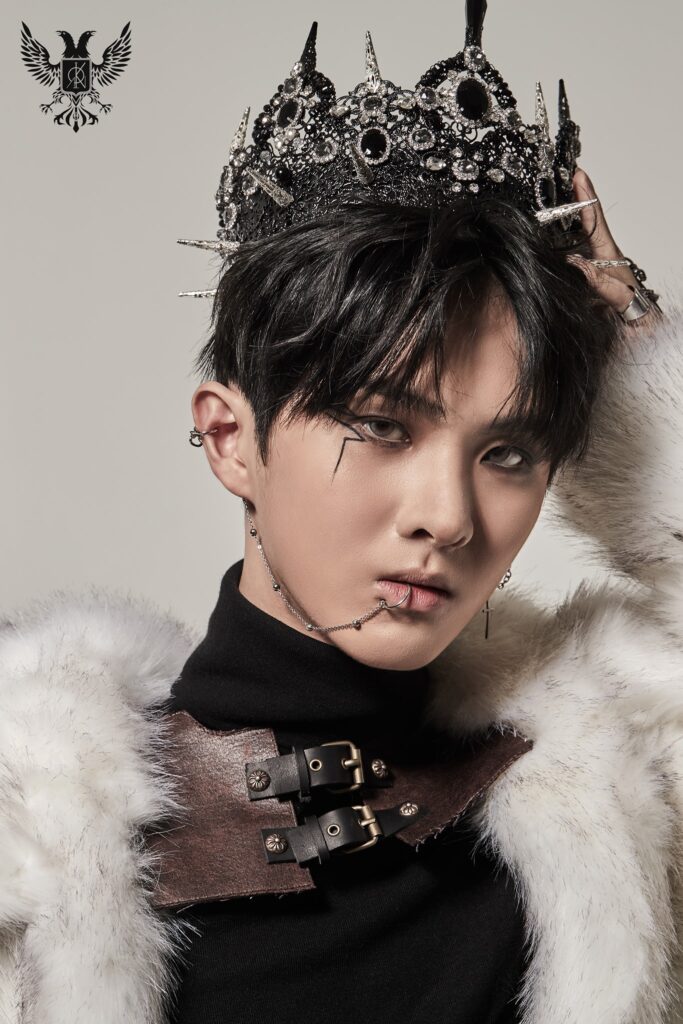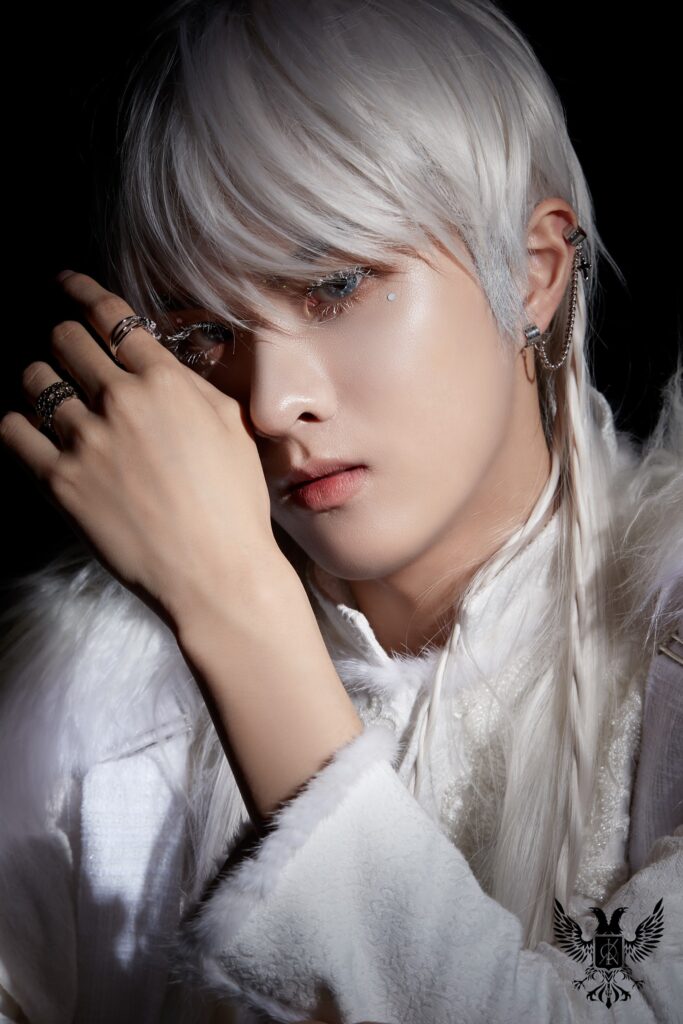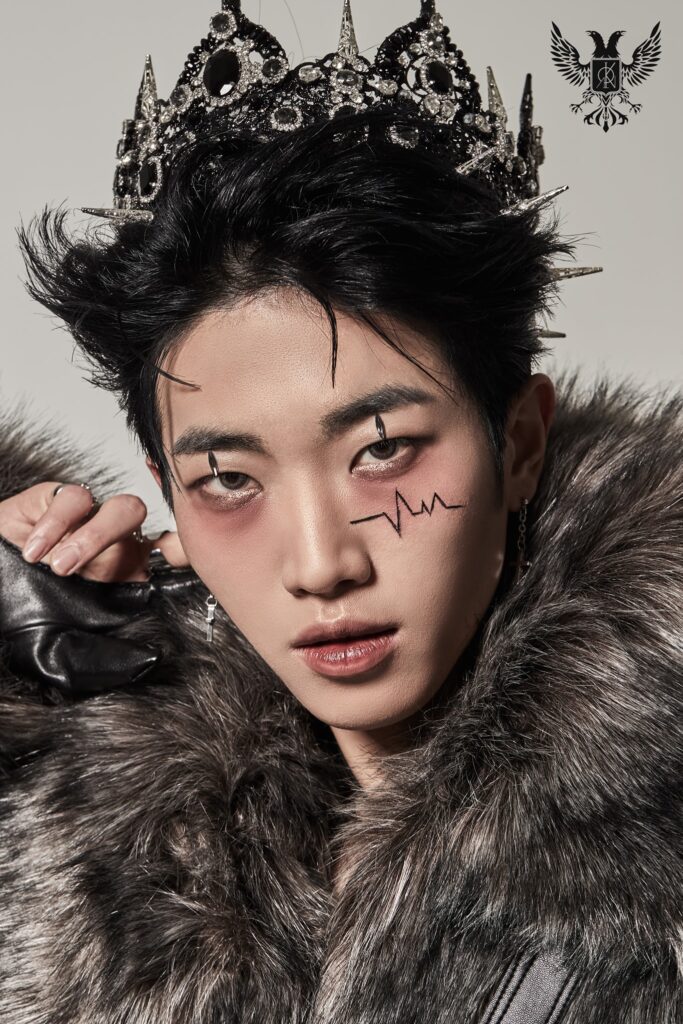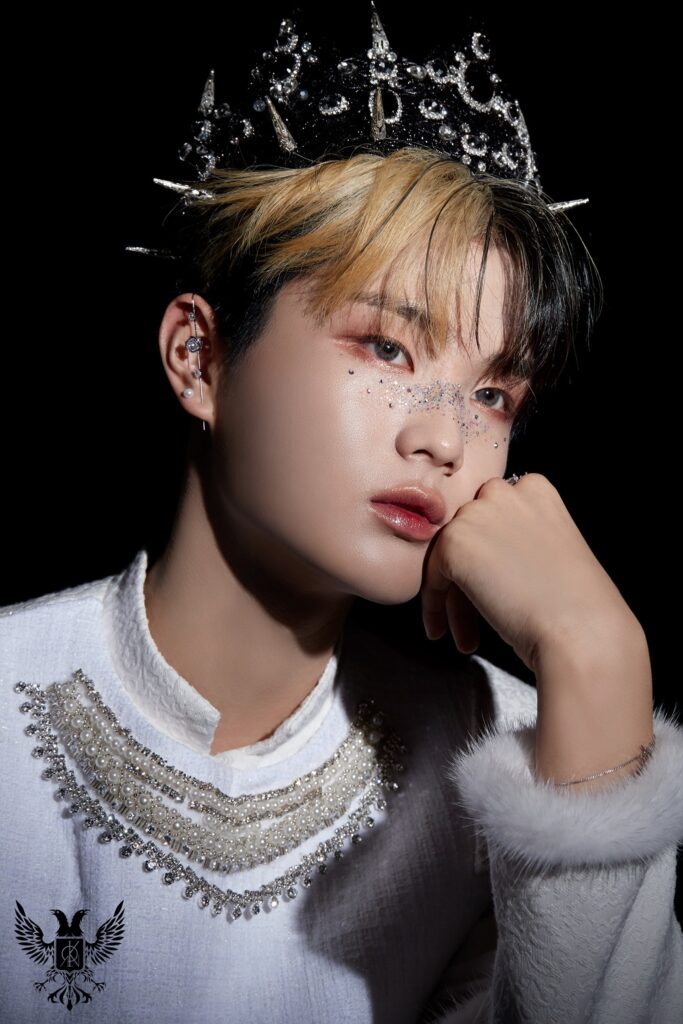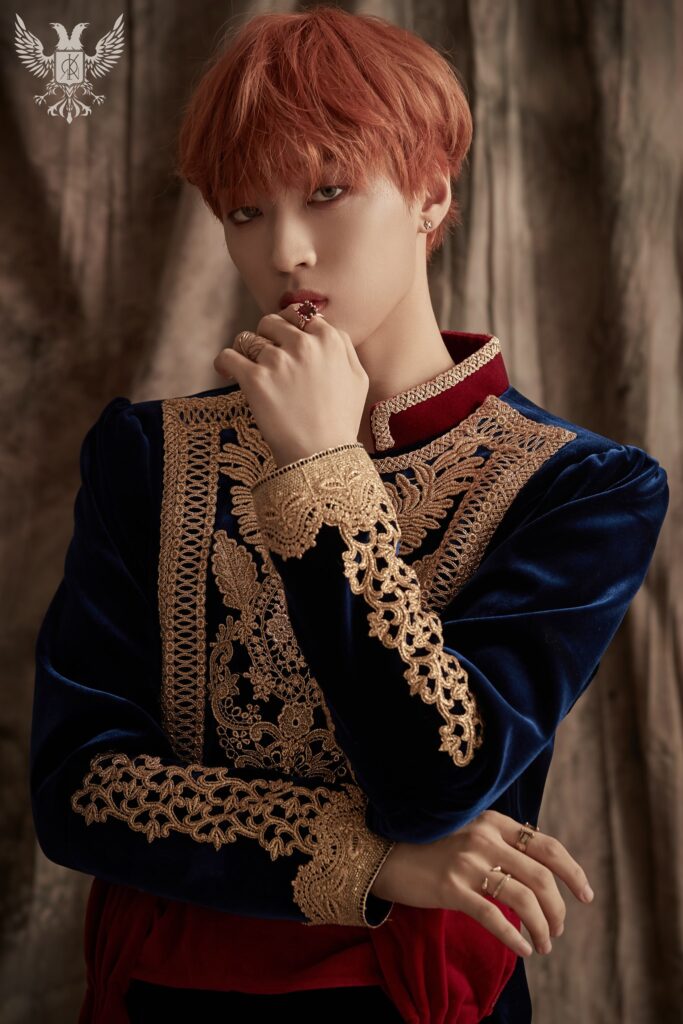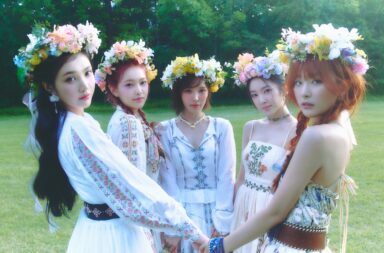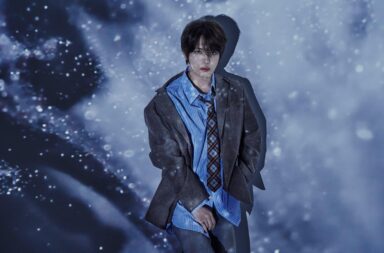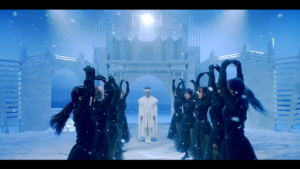
In the frigid, icy wilderness lies two groups: a rugged dark Kingdom in chains and furs, and a pristine pure Kingdom, clad all in bright white and silver. Through the snow emerges the protagonist, Ivan (of the Kingdom of Snow), a black menacing crown adorning his head and a steely gaze in his eyes. As he sinks to his knees, a figure in a black cloak approaches, grasps Ivan’s head, and his eyes glaze over to a gruesome, ominous white.
Kingdom’s previous MV “KARMA” saw the members straight out of a temple the likes of a scene from The Untamed or mythical Shangri-La, and similar to their debut MV “Excalibur,” there appear to be two distinct styles of clothing: light and dark. However, rather than just contrasting styles, Kingdom’s newest album, History of Kingom: Part III. Ivan, suggests there are actually two entirely different Kingdoms: a righteous one and a chaotic one that lusts for a “power that has grown beyond [their] control” and “transcends good and evil.” It is not even immediately clear which is good and which is evil. In the MV, they are actually seen fighting the meta versions of themselves and coming out victorious, throwing a twist into the lore that the group has been building since their debut.
Not only that, but the narrative that Kingdom are crafting suggests that they are not just historical kings, but travel across time to collude with each other against an unknown force. Seeing as each MV shows the full group in period and setting appropriate clothing, rather than a mix of what you would expect from their native timeline or country, it seems each instalment is a snapshot of the members travelling to that specific time either to fight against an unknown protagonist or to retrieve the respective ruler of that time. The dissonance between the two light and dark groups ultimately reaches a climax when both groups clash, with dark Ivan grasping his snow-white doppelganger and strangling him before discarding him in the snow.
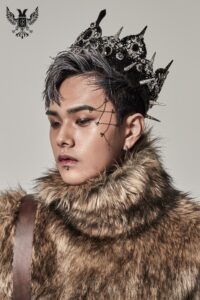
While I still remain wary of Kingdom’s use of other countries’ history and lore for conceptual fodder and profit, the detail that they do include to characterize Ivan’s world in the MV is pretty impressive. This whole concept is based on Ivan the Terrible, Russia’s first tsar, who reigned from 1547 until his death in 1584. While the beginning of the child prince’s reign was marked with relative peace, betrayal of one of his closest friends in 1558 and the death of his first wife Anastasia under suspicious circumstances in 1560 transformed him a from peaceful ruler into a paranoid tyrant.
Ivan’s descent into torture and distrust saw Russia split into two distinct regions, one that was ruled by the nobility and another, called the Oprichnina, that was ruled by Ivan himself and his band of personal bodyguards, the Oprichniki. These ruthless and unforgiving figures would roam the Oprichnina carrying out Ivan’s bidding and executing anyone suspected of disloyalty. Ivan’s massacres of his own people, brutalizing of his family, and escalating paranoia has left a dark stain on Russia’s history and led historians to question his mental stability after 1558.
All of this to say, there are reverberations of these elements all throughout the MV. Even from the intro (aptly titled “Legacy of Hatred”) and the beginning of “Black Crown” when Ivan in white enters the snowy palace, his dancers, clad all in black, “unfreeze” at the tsar’s entrance into this timeline. In addition to reinforcing Ivan as a ruler with immense power and influence, the movements of the dancers also support the otherworldly outside-of-time aspect of the Kingdom lore.
The dancers could likely represent the Oprichniki since their presence is felt all throughout the MV. The figure at the beginning that ensnares Ivan’s black-crowned head and when his eyes turn white are the same as those that appear in the subsequent scenes. Also, the dancers’ limbs are frequently seen surrounding the members, enticing them towards the “cruel but beautiful dangerous power” and “prison without bars” that they allude to in their lyrics. With that being said, the dancers could also represent darkness and death, even adorning black veils that obscure their faces in some scenes.
The members in normal clothes (not the ragged, fur-lined, and chained ones) sing about enduring “the pain of astonishing power” and putting on the metaphorical black crown, unlocking something even more sinister. However, as they accept the danger of this fate, they become increasingly feral, even leading them to clash with their light doppelgangers.
The struggle between their alternate selves could be both a representation of Ivan the Terrible’s struggles with his own paranoias, as well as a threatening subplot of Kingdom’s own expanding lore. The animalistic element is further highlighted by the deep growls that punctuate the song and MV, driving home the contrast between the two Kingdoms and adding a dark undertone to the sound and imagery.
There are other small echoes of Ivan the Terrible’s story like the Cathedral-like architecture, ornate throne, and the introduction that sounds like a combination of a church choir and a demented music box. Misplaced as it may be, the music box is reminiscent of the one Anastasia possesses in the animated movie of the same name (though not the same Anastasia that was wed to Ivan), while the church choir draws on inspirations from Russia’s predominantly Orthodox Christian ties.
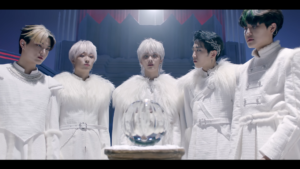
In addition to the dancers, a mysterious figure in a black mask also appears throughout the MV holding a strange orb that the light (not yet manic) members seem to be seeking to obtain. However, while it is clear when it is with the members, it is an inky black when it lies atop the lap of the masked figure wearing the black crown. The identity of the figure remains a mystery, but the threatening aura and danger that it imparts on both the black crown and the weird orb are striking. To revive a Lord of the Rings parallel, its evil influence is reminiscent of the One Ring that is able to bind and control its wearer.
The music that accompanies much of the MV is unsurprisingly primal and imposing. The members’ intense vocals are supported by orchestral tracking, prominent brass, and organ parts. With such a thick texture, the music gives the illusion of tension and power, exemplified by the punctuations of “we run the world,” “brutal black black crown,” and “get wild” in the chorus. As the song reaches a climax, the bridge abruptly shifts to the creepy sounds heard in the introduction before the music cuts out, replaced by a guttural growl that ushers in the final chorus. One of the final lyrics heard is “kings never die,” not only giving words to the very real repercussions of the actions of powerful rulers, but furthering the reincarnation, time-bending narrative that the group has been building so far.
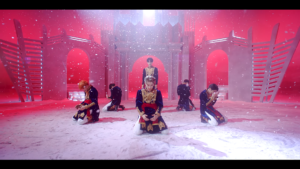
In the last scene, the choreography shows the members adorning crowns before sinking to their knees in a circle surrounding Ivan. The story is left relatively open-ended, but what is clear is that the members are amassing enormous amounts of an unfathomably dark power that might have corrupted them and their meta versions in the process.
Surprisingly, the rest of the tracks on the album (except the intro) are mostly hopeful and light in sound and context. Two songs, “Fallen Star” and “ON AIR,” are up-tempo ballads while “We Are” and “Burn” are pop-forward, fun tracks featuring very few of the dark elements from “Black Crown.”
“Fallen Star” and “ON AIR” are beautiful. The former describes a yearning to be someone’s fantasy and make them happy. The sustained block chords, sparse half time drum set, and the members’ vocals are most prominent in the mix, and the slow movement of the instrumentals give the music a lofty floating sound. The tempo is laid back and the vocals often hang out in the falsetto range, except for the intimate voices that make the listener sound like they are being directly serenaded to. With the floaty-ness of the sound and sweetness of the vocals and lyrics, “Fallen Star” is surprisingly gentle following the roughness of “Black Crown.”
Compared to “Fallen Star,” “ON AIR” sounds like the honeymoon period of a lovely romance rather than a protagonist dreaming of love. The lyrics emphasize how real life feels like a dream or “out-of-focus camera” with a repeated “I can’t breathe” emphasizing the excitement of breathless romance. The gang vocals and catchy “woo oh”s in the chorus invite listeners to sing along and experience the romance with them. Rather than the weightless instrumentals of “Fallen Star” the instrumentals are more grounded with the drums and bass on the beat and in the forefront of the mix throughout.
The two middle tracks “We Are” and “Burn” are evocative and excite the listener with talk of extraordinary love and hopeful pursuit. The former is funky and fun. A synthesizer with a melody introduced at the very beginning of the song remains a prominent feature in the music, providing a nice accompaniment to the members’ mid-range, playful vocals. “Burn” by comparison is more sensual and reflective. The synthesizer is prominent again, but with a thicker, chordal sound and syncopated rhythm. The pre-chorus and chorus are electrifying and triumphant where “We Are” was alluring with a texture that remains busy and exciting throughout.
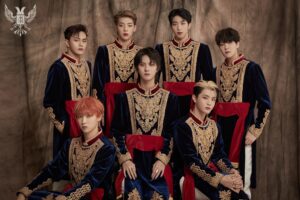
The MV teased Dann, of the Kingdom of Change, as the next protagonist in the saga. Contrary to (my) predictions, he seems to be Dangun, the founder of Korea’s first kingdom Gojoseon rather than Halfdan, the Viking founder of the Danish kingdom of York. While both have Dan in their name, Dann’s clothes in the teaser at the end of “Black Crown” resemble a Joseon era Hanbok than any kind of Viking clothing. This makes sense with his status as the leader of the Kingdom of Change also, since Dangun is regarded as the “originator of the Korean people” in some accounts.
I think it may be safe to say that while exactly what Kingdom seem to be fighting, whether it is an anti-version of themselves or an unknown protagonist, is unclear for now, the story does seem to be ramping up for quite a cinematic next chapter. The entire series is supposed to be eight individual instalments and describe the group’s whole history, leaving room for a lot to happen in between. With so much time to world build, I look forward to seeing how the group and their company continue to ramp up the tension and craft a meaningful story without losing steam or venturing dangerously close to cultural appropriation.
(YouTube [1][2][3][4], Harper’s Bazaar, Britannica [1][2][3], History.co.uk, Fandom, Department of Languages and Literatures at Lehman College/CUNY, Medium, Encyclopedia of Korean Folk Culture, Korea.net (Korean Culture and Information Service), Lyrics via GF Entertainment and foolmeg via YouTube, Images via GF Entertainment)
